Large aquarium fish are some of my favorites to keep. Often stately and always hungry, these are the perfect fish for aquarists with deep tanks, deeper pockets and plenty of space! Here are 11 large freshwater aquarium fish to consider for your next 200+ gallon tank!
Our Favorite Large Freshwater Aquarium Fish
Here are 11 of our favorite large freshwater aquarium fish:
Blue Umbee Cichlid
Cichlids are infamous for being large, mean, and a handful for aquarists. However if there’s one cichlid that embodies all of these qualities, it’s the Blue Umbee.
These monster fish are found in Panama and Colombia where they live as alpha predators in their domain. They are much better known by fishermen, in fact, who come from all over the world to land these hard hitting, harder fighting fish!
Blue Umbees need tanks no smaller than 250 gallons as adults and they will do plenty of their own aquascaping. Digging, shredding plants, and punishing tank mates who intrude into their chosen domain is a given.
And if a pair should spawn you’re better off removing every other fish as they will be relentlessly bitten to death.
- Scientific Name: Kronoheros umbriferus
- Origin: Panama & Colombia
- Size: 20 inches
- Temperament: Aggressive
Black Pacu
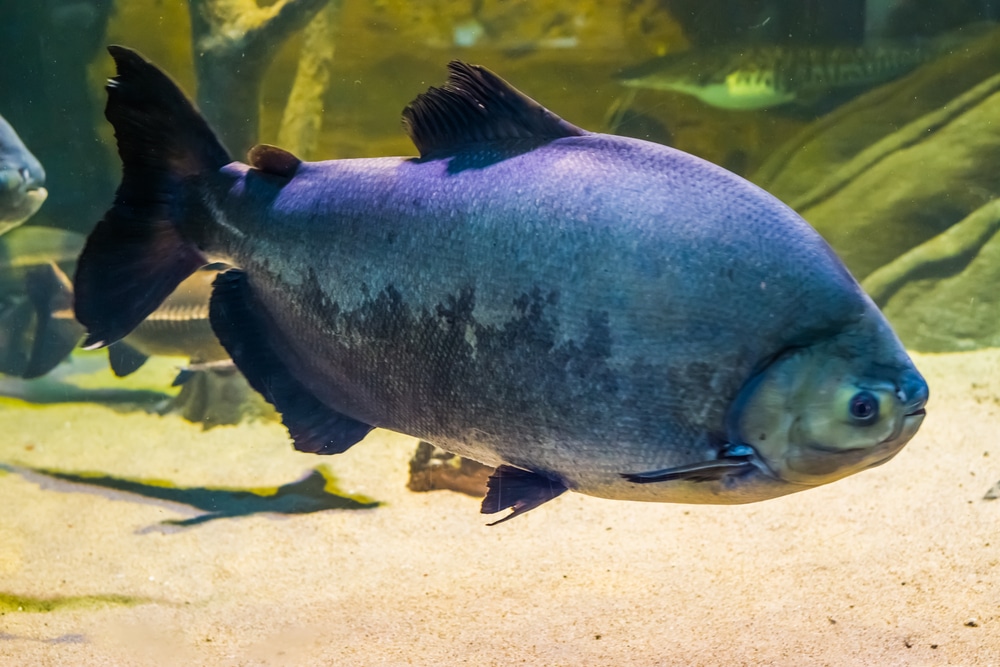
If you’re a fan of Tetras then you’re already familiar with the Characin family. This diverse group of fish also includes Silver Dollars, Piranhas, and the enormous Black Pacu.
Far larger than a Neon Tetra, Black Pacus are the largest of the family. Like Piranhas Pacu also have large teeth however they look almost exactly like human molars. This is because Pacu are almost entirely vegetarian, hunting for fruit and seeds in flooded forests.
Black Pacu can crunch through just about any plant matter and should be given carrots, zucchini, and other vegetables regularly. Plants are guaranteed to be eaten, even tough, bitter plants like Anubias or Java Fern.
Considering how massive they grow, Black Pacu need at least 600 gallons of space to swim freely as adults. In nature, they form massive schools when migrating to spawn.
When not spawning Pacu don’t school but are peaceful towards each other and other fish. But make sure you’re willing to make a lifelong investment. Well cared for Black Pacu are known to live anywhere from 40 to 65 years!
- Scientific Name: Colossoma macropomum
- Origin: Amazon basic
- Size: 30-40 inches
- Temperament: Peaceful
Red Tail Catfish
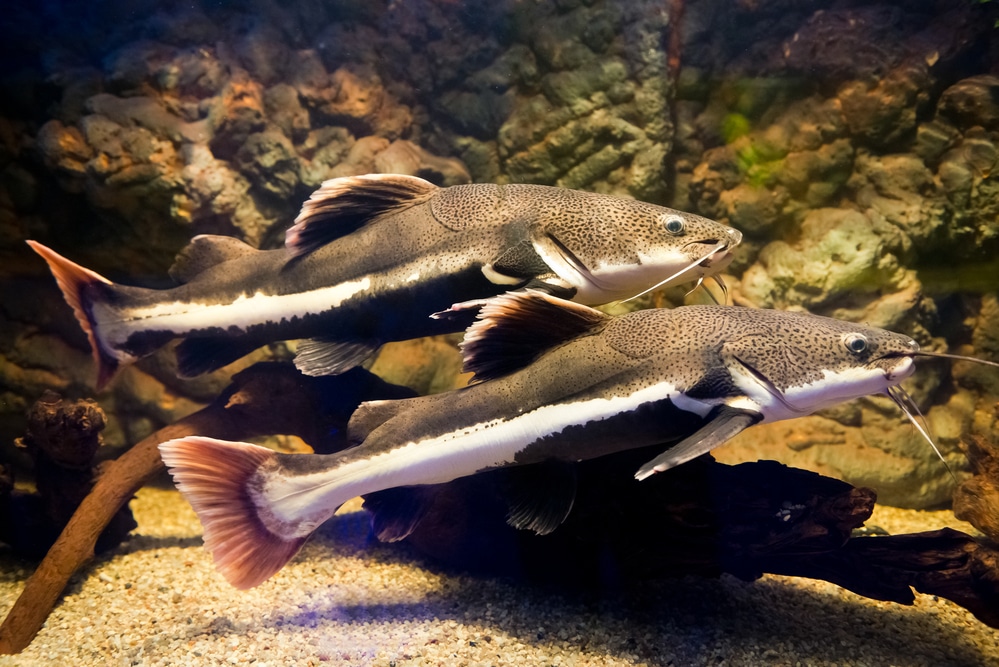
Voraciously hungry and fast growing, Red Tail Catfish are some of the most common large freshwater aquarium fish available. Unfortunately, they are a poor choice for most fish keepers.
They can grow as long as 5 feet, making them suitable only for the largest tanks or indoor ponds. Assuming you can provide this they are hardy and undemanding. They prefer soft, slightly acidic water conditions.
And given the amount of waste they create, heavy filtration is essential. Aquarists typically use heavy duty canister filters that contain enough biomedia to break down nitrogenous waste into nitrate.
Red Tail Catfish have the bad habit of swallowing anything that finds its way into their mouths. If they happen to suck in a meal and some gravel makes its way in as well it’s likely to be swallowed.
This can cause intestinal blockage and possible death. So always keep these fish on either sand substrates or bare bottomed tanks for their own safety.
- Scientific Name: Phractocephalus hemioliopterus
- Origin: Amazon & Orinoco River basins
- Size: 3-5 feet
- Temperament: Semi-aggressive; Predatory
Alligator Gar
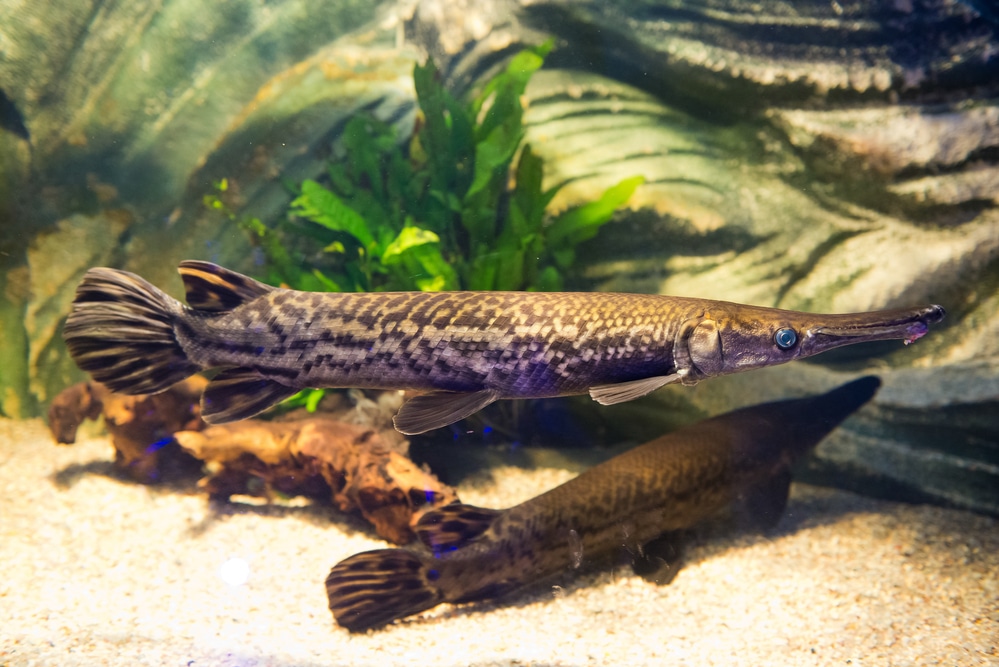
Gars are unusual but not too hard to find and the largest is the Alligator Gar. These fish have bony scales so tough that Native Americans used them for arrowheads and breastplates.
As the name suggests, Alligator Gars have a flat, bony head with a mouth full of vicious teeth. Typically Gars lurk just beneath the surface, waiting for the right sized fish, frog, snake, or even a small bird to float by. They then attack instantly, shredding their prey with their fangs.
When young they are easy to care for but grow fairly quickly. They are usually not aggressive towards tank mates they can’t eat but occasionally Gar may decide to lash out. And given how large their teeth are they can easily kill larger fish.
Once your Alligator Gar tops 3-4 feet it’s probably time to look at rehoming them. Fortunately, they are native to the USA and can overwinter in outdoor ponds that are deep enough.
- Scientific Name: Atractosteus spatula
- Origin: North America
- Size: 6 to 10 feet
- Temperament: Semi-Aggressive; Predatory
Peacock Bass
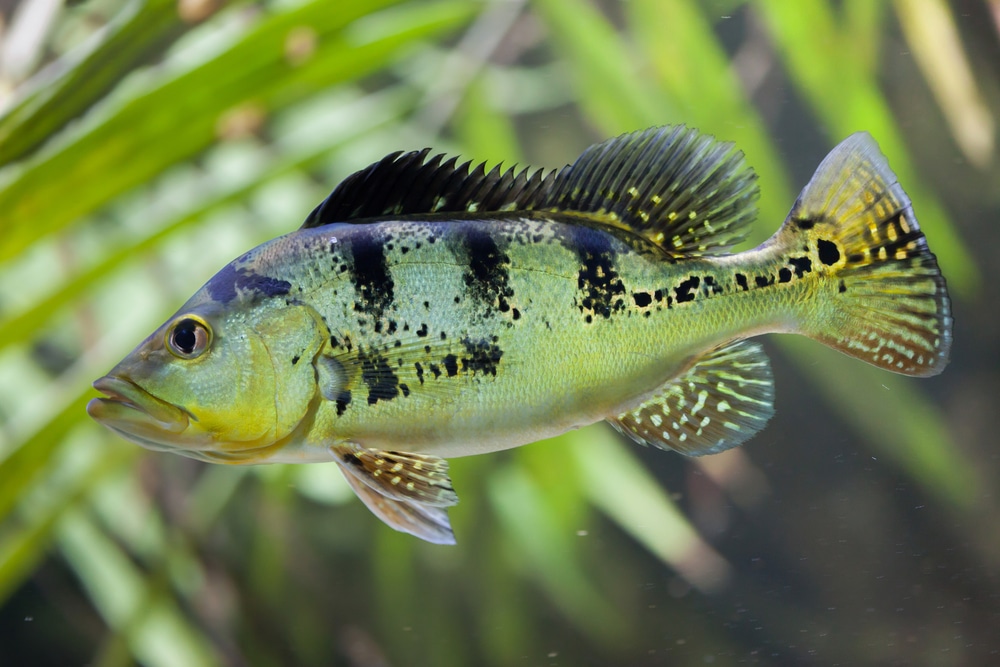
Peacock Bass are actually tropical cichlids and the Tucunare (Cichla temensis) is possibly the largest cichlid on Earth. Like the Blue Umbee, they are very popular targets for game fisherman and have even been introduced to South Florida.
As large predators, Peacock Bass need a constant stream of high quality fresh and frozen foods like chopped meat and feeder goldfish. The absolute minimum of a tank is 250 gallons with larger always being better.
For cichlids, Peacock Bass are peaceful. So long as they can’t eat their tank mates they tend to ignore other fish. However their mouths are a lot larger than you might think and they might try to wolf down a tempting tank mate anyway.
- Scientific Name: Cichla sp.
- Origin: South America
- Size: Up to 3 feet
- Temperament: Semi-Aggressive; Predatory
Giant Snakehead
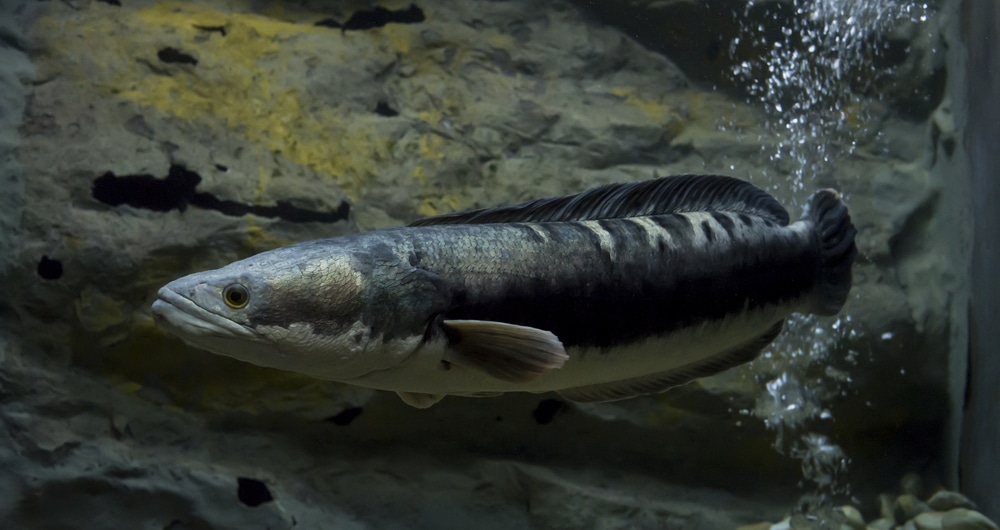
Snakeheads are Asian food fish that occasionally make it into the aquarium trade. Most are medium sized however the Red or Giant Snakehead is a true monster.
Quickly growing up to 4 feet long and 40 lbs these fish need massive, secure aquariums because they can easily escape from a pond!
When fully grown Giant Snakeheads are a real challenge to keep with other fish. They are aggressive and will often bite intruders, even the hand that feeds it. They have especially large teeth so getting bitten is no laughing matter.
Snakeheads will regularly try the lid as well, trying to escape. In nature they slither across marshy fields to new canals and streams.
And given their ability to partially breathe air they can survive for hours of the water. Be very careful where you step at night if sleeping in the same room as a Snakehead…
- Scientific Name: Channa micropeltes
- Origin: Southeast Asia
- Size: 3 to 4 feet
- Temperament: Aggressive; Predatory
Iridescent Shark
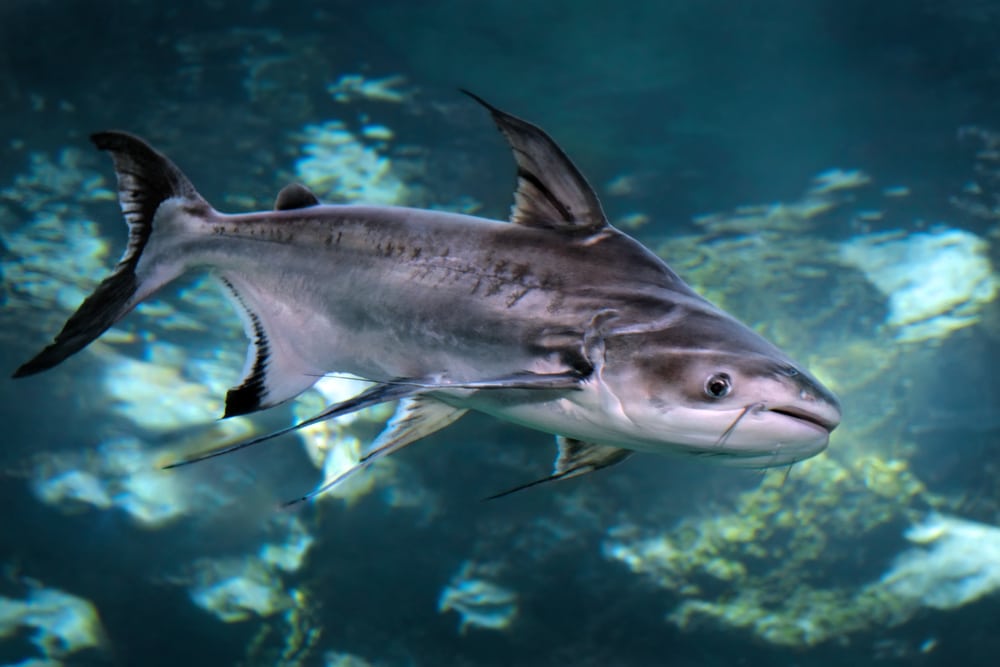
While called freshwater sharks, the Iridescent Shark is actually a giant catfish from Southeast Asia. You might be more familiar with them than you think. If you’ve ever purchased Swai fillets in the grocery store you eventually had some for dinner.
They are raised in huge outdoor ponds in Asia for food but a few make it across the ocean as aquarium fish. Unfortunately, they are a poor choice for most fish keepers. Not only do they grow 4 feet long but they will eventually eat their tank mates they outgrow.
That said, Iridescent Sharks are hardy, beautiful, and much more active than typical bottom dwellers like Plecostomus. So long as you provide them with tropical temperatures (78-82℉) and enough space, they will do well.
- Scientific Name: Pangasianodon hypophthalmus
- Origin: Southeast Asia
- Size: Up to 4 feet
- Temperament: Peaceful; Schooling
Giant Gourami
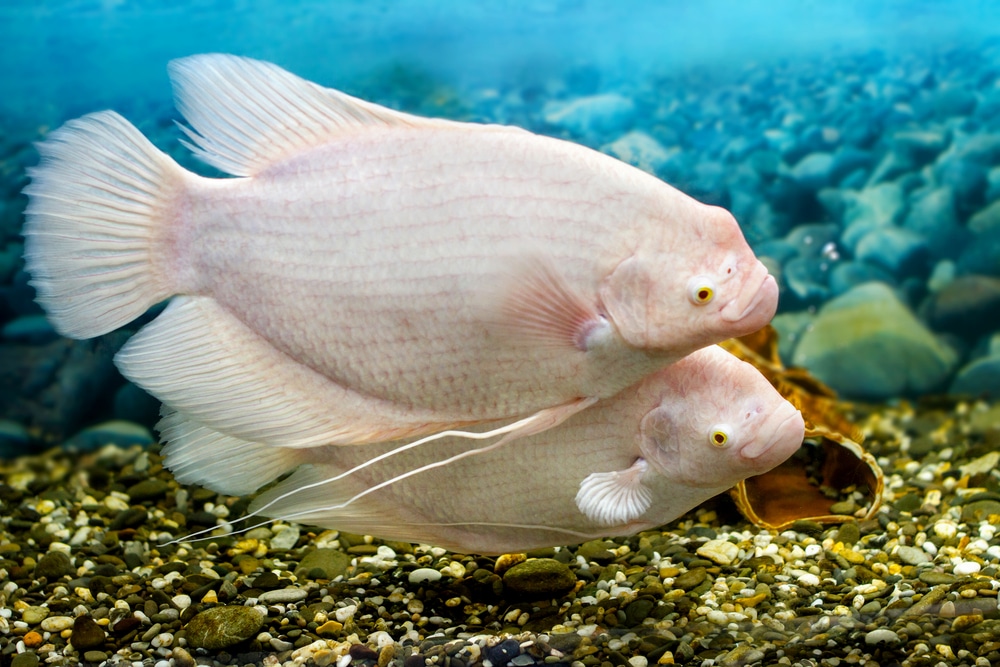
Unlike nearly every other Anabantoid fish (Bettas & Gouramis) the Giant Gourami is mostly vegetarian. Soft aquatic plants like Elodea and Cabomba are their favorite things to eat, with occasional servings of invertebrates like bloodworms and chopped shellfish.
Offer them thawed peas and blanched vegetables as well alongside vegetarian fish pellets. Other omnivores like Barbs and Goldfish need veggie-based prepared foods offered frequently.
And like other Anabantoid fish, Giant Gouramis can be bullies sometimes. They aren’t as nasty as cichlids or snakeheads but they will readily nip their way to the front of the line when it’s time to eat.
However they are personable, intelligent, and even recognize their keepers. So long as you have at least 300 gallons of space for one the Giant Gourami is a fascinating fish to keep!
- Scientific Name: Osphronemus goramy
- Origin: Southeast Asia
- Size: 30 inches
- Temperament: Semi-aggressive
Black Devil Catfish
While Red Tail cats are predators they are easygoing in temperament. However there are some Catfish that go against the “slow and gentle” idea people have for them!
As you can see in the video above, Black Devil Catfish really earn their name as they are extremely territorial. Even if they can’t eat their tank mates they will claim most of the aquarium bottom and viciously bite anything that comes near.
When kept in tanks larger than 1000 gallons or ponds they can claim enough space. Plus their tank mates learn to keep their distance.
Most keepers keep them alone where these beautiful midnight black catfish can cruise to their heart’s content.
- Scientific Name: Hemibagrus wyckii
- Origin: Thailand
- Size: 28 inches
- Temperament: Highly Aggressive; Predatory
West African Lungfish
These are true living fossils that go back nearly 400 million years to the first vertebrates to leave the water!
As you’d expect Lungfish are extremely hardy. They thrive even in muddy oxygen-poor conditions and can survive up to 3 ½ years without food by hibernating in moist mud.
In aquariums Lungfish are easy to keep but should be kept alone. They tend to snap at anything that floats by and have very poor eyesight. However their sense of smell is excellent; chopped fresh fish, clams, and shrimp are even better than live food.
While huge West African Lungfish aren’t very active. As a result they can live in aquariums as small as 180 gallons when fully grown.
- Scientific Name: Protopterus annectens
- Origin: West Africa
- Size: 3 feet
- Temperament: Semi-Aggressive; Predatory
Mbu Puffer Fish
Puffer Fish are cute, unusual looking fish but beware. They love to investigate things with their mouths, including tank mates and fingers!
Mbu Puffers are the largest of the bunch, growing up to 3 feet long. Assuming you have at least 300 gallons of space they make fascinating pets!
Puffer Fish feeding needs careful consideration. In the wild they eat mostly hard shelled invertebrates so their teeth grow continually. They need clams, crayfish, mussels, and other crunchy food to keep their teeth properly worn down.
Mix in pellets and softer items on occasion but fresh shellfish is mandatory for good health. Being extremely messy eaters and big carnivores, Mbu Puffer Fish create tons of waste so adequate filtration is essential.
They are sensitive to buildups of ammonia in particular so you may need to do frequent water changes even if you have decent filtration.
- Scientific Name: Tetraodon mbu
- Origin: East Africa
- Size: 30 inches
- Temperament: Aggressive; Predatory

